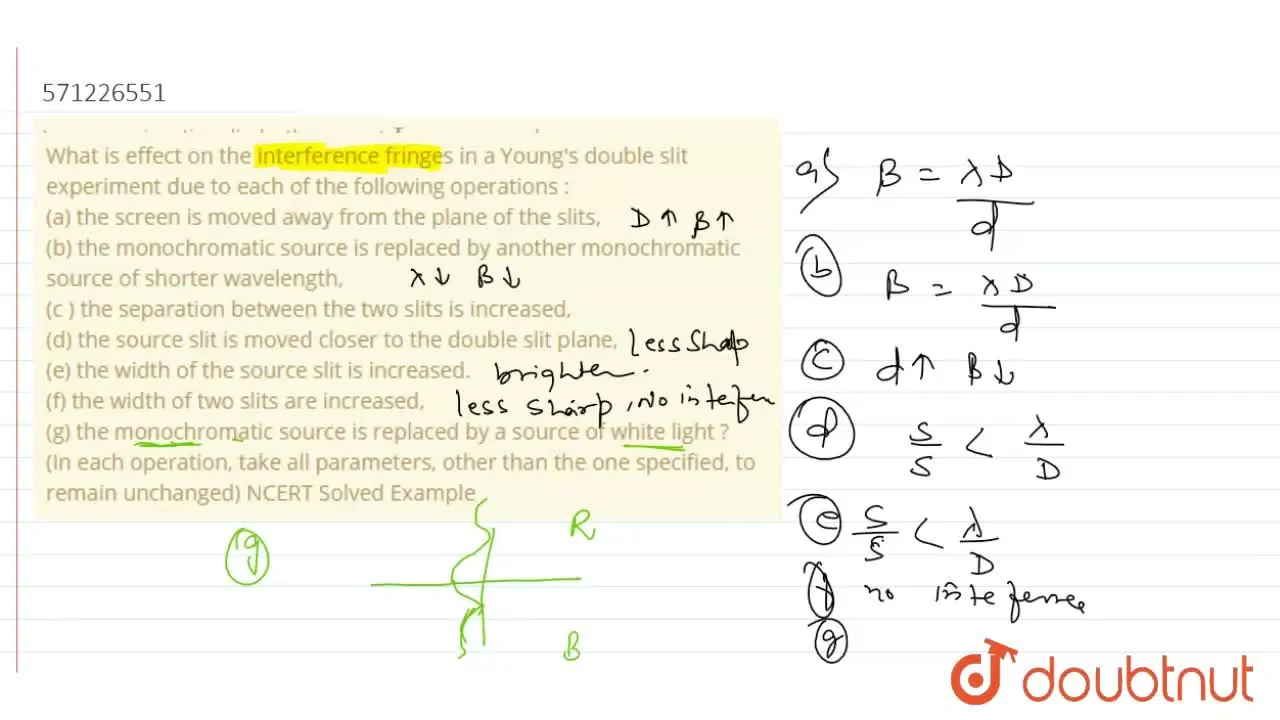What is effect on the interference fringes in a Young's double slit experiment due to each of the following operations :
(a) the screen is moved away from the plane of the slits,
(b) the monochromatic source is replaced by another monochromatic source of shorter wavelength,
(c ) the separation between the two slits is increased,
(d) the source slit is moved closer to the double slit plane,
(e) the width of the source slit is increased.
(f) the width of two slits are increased,
(g) the monochromatic source is replaced by a source of white light ?
(In each operation, take all parameters, other than the one specified, to remain unchanged) NCERT Solved Example
(a) Angular separation of the fringes remains constant (=λ/d). The actual separation of the fringes increases in proportion to the distance of the screen from the plane of the two slits.
(b) The separation of the fringes (and also angular separation) decreases. See, however, the condition mentioned in (d) below.
(c) The separation of the fringes (and also angular separation) decreases. See, however, the condition mentioned in (d) below.
(d) Let s be the size of the source and S its distance from the plane of the two slits. For interference fringes to be seen, the condition sS<λ/d should be satisfied, otherwise, interference patterns produced by different parts of the source overlap and no fringes are seen. Thus, as S decreases (i.e., the source slit is brought are seen. Thus, as S decreases (i.e., the source slit is brought when the source is brought too close for this condition to be valid, the fringes disappear. Till this happens, the fringe separation remains fixed.
(e) Same as in (d). As the source slit width increases, fringe pattern gets less and less sharp. When the source slit is so wide that the condition s/S≤λ/d is not satisfied, the interference patter disppears.
(f ) The interference patterns due to different component colours of white light overlap (incoherently). The central bright fringes for different colours are at the same position. Therefore, the central fringe is white. For a point P for which S2P−S1P=λb/2 where λb(≈4000Å) represents the wavelength for the blue colour, the blue component will be absent and the fringe will appear red in colour Slightly farther away where S2Q−S1=λb=λr/2 where λr(≈8000Å) is the wavelength for the red colour, the fringe will be predominantly blue. Thus, the fringe closest on either side of the central white fringe is red and the farthest will appear blue. After a few fringes, no clear fringe pattern is seen.
Related Playlists
Similar Questions
What is the effect on the interference fringes in a Young.s double-slit experimental due to each of the following operations :
The width of the source slit is increased.View SolutionWhat is the effect on the interference fringes in a Young.s double-slit experimental due to each of the following operations :
The monochromatic source is replaced by a source of white light?View SolutionIn Young's doble-slit experiment, if the monochromatic source of light is replaced by white light, then one sees
View SolutionYellow light of wavelength 6000 Ã… produces fringes of width 0.8 mm in Young's double slit experiment. If the source is replaced by another monochromatic source of wavelength 7500 Ã… and the separation between the slits is doubled then the fringe width becomes
View SolutionHow does the fringe width, in Young's double-slit experiment, change when the distance of separation between the slits and screen is doubled ?
View SolutionHow would the angular separation of interence fringes in Young's double slit experiment change when the distance between the slits and screen is halved ?
View SolutionHow would the angular separation of interference fringes in Young's double slit experiment change when the distance of separation between slits and screen is doubled ?
View SolutionIn a Young's double slit experiment, the slit separation is 1mm and the screen is 1m from the slit. For a monochromatic light of wavelength 500nm, the distance of 3rd minima from the central maxima is
View SolutionIn Young's double slit experiment if monochromatic light is replaced by white light
View SolutionA Young's double slit experiment uses a monochromatic source. The shape of the interference fringes formed on a screen is
View Solution


